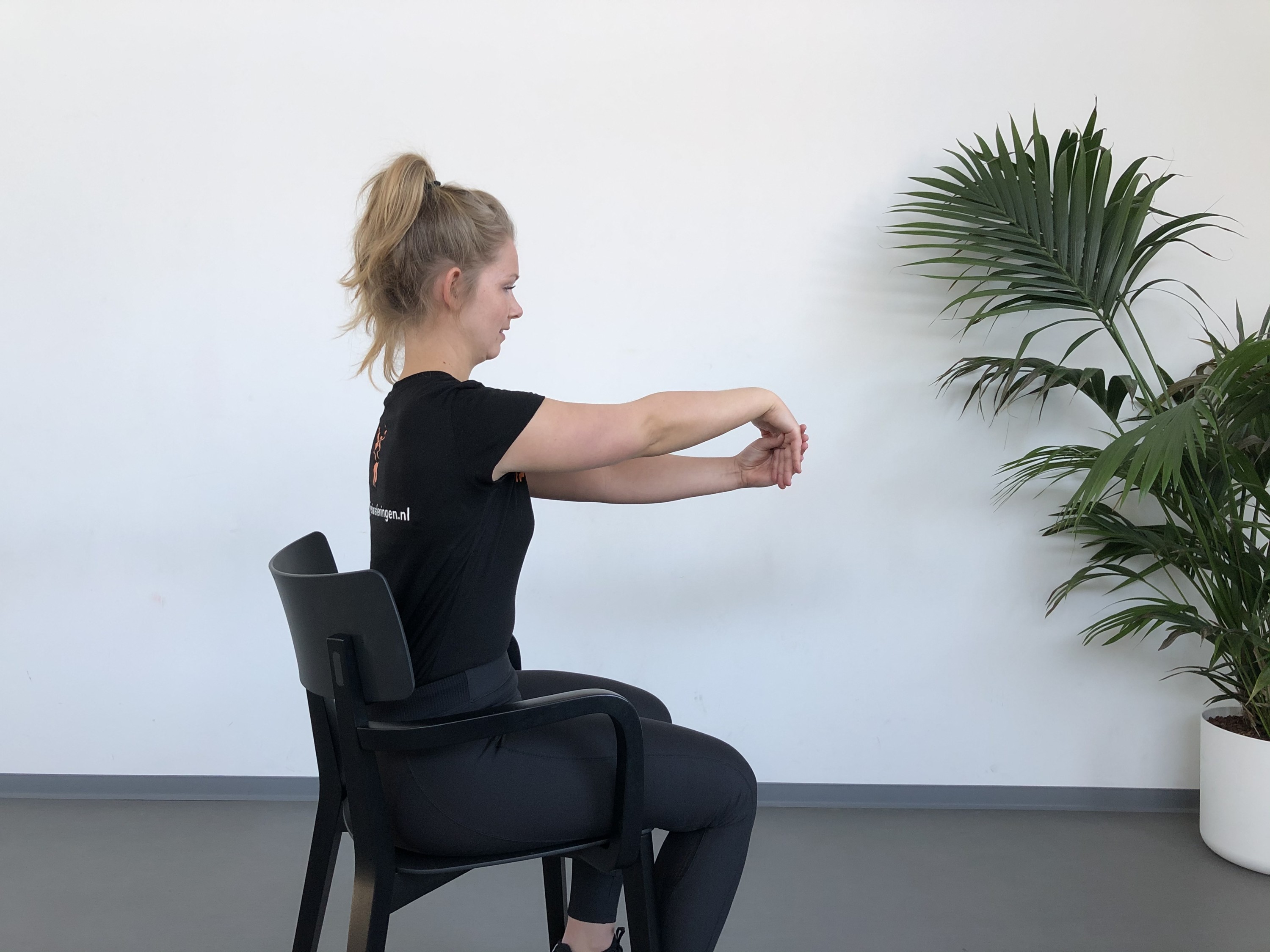
Tennis elbow
Tennis elbow is defined as an irritation or inflammation of the tendon of the extensor muscles of the forearm. These tendons attach to the outside of the forearm, at the elbow joint. Find all information and various exercises here.
Phase 1 of recovery
In this phase, the goal is to start low load exercises for the extensor muscles and tendon of the forearm within the pain limits.
1. Olifantenoren
Neem plaats op een stoel. Breng uw handen naar de oren en de ellebogen zijwaarts. Beweeg de ellebogen vervolgens naar voren en weer zover mogelijk zijwaarts.
2. CTO mobilisatie
Houdt de armen op schouderhoogte naast u. Kijk naar één zijde draai de hand waar u naar kijkt open omhoog en de andere arm (waar u dus niet naar kijkt) omlaag. Wissel deze beweging af.
3. Zittend rekken extensoren
Ga zitten, breng vervolgens uw gekwetste arm omhoog ten hoogte van uw schouder. Wijs vervolgens met uw volledig hand naar de vloer terwijl uw arm gestrekt op schouderhoogte blijft. Pak de hand die naar de vloer wijst vervolgens vast met uw overige hand. Draai de hand van het kwetste arm vervolgens naar buiten, waardoor de pols naar binnen draait. Herhaal dit.
Phase 2 of recovery
During this phase, the goal is to strengthen the tendon and muscles through exercises. It is important to gradually build up the load on the tendon.
1. 2D diagonaal flexie
Ga op het breedte staan, pak de elastiek met het aangedane arm, de gezonde arm blijft langs het lichaam, breng de aangedane arm naar beneden richting je andere hand en kom langzaam weer terug.
2. 2D diagonaal extensie
Ga op het breedte staan, pak de elastiek met het aangedane arm, breng je arm gestrekt zijwaarts omhoog en kom weer langzaam terug.
Resistance band
Hard. Compact. Qualitatively.

What means a tennis elbow (epicondylitis lateralis)
Three bones join together to form the elbow joint; the upper arm (humerus) and forearm (radius and ulna). Tennis elbow is an irritation or inflammation (tendinitis) of the junction of muscle and tendon (myotendinous junction), the junction of bone and tendon (entheses) or the extensor muscles of the forearm. The tendons of these muscles attach to the outer side of the elbow on the upper arm bone (humerus).
The causes of a tennis elbow (epicondylitis lateralis)
Tennis elbow can have an acute onset, but more often starts gradually as a result of overuse through repetitive motions like lifting, squeezing, gripping or turning. A desk job can also cause tennis elbow.
The symptoms of a tennis elbow (epicondylitis lateralis)
Pain on the outer side of the elbow is often diagnosed as tennis elbow. Reduced strength in the forearm and hand, pain in the forearm radiating to the thumb, tingling or numbness in the forearm can all be symptoms. Ask a physiotherapist with experience in treating elbow pain if your pain is caused by tennis elbow. Physical examination of the and sometimes ultrasound imaging are needed.
The treatment of a tennis elbow (epicondylitis lateralis)
Exercises in combination with treatment by a physiotherapist are often recommended to reduce or resolve your symptoms. There are other treatment options like percutaneous electrolysis (EPTE) or shockwave therapy (ESWT). Generally most (90%) people recover within a year provided some care is taken to avoid aggravation of the elbow. The elbow will heal naturally if you allow the body to do so and is always the preferred choice.
Synonyms
Lateral epicondylitis, lateral epicondylalgia, elbow pain
Advice
If you have any questions regarding the exercises, doubt if you are doing them correctly or aren’t sure they are suited for your condition, please contact your physiotherapist for support.
Attention:
Yourbody.coach offers a range of exercises. Yourbody.coach can not be held responsible if you develop injuries. Always consult your physiotherapist or specialist.